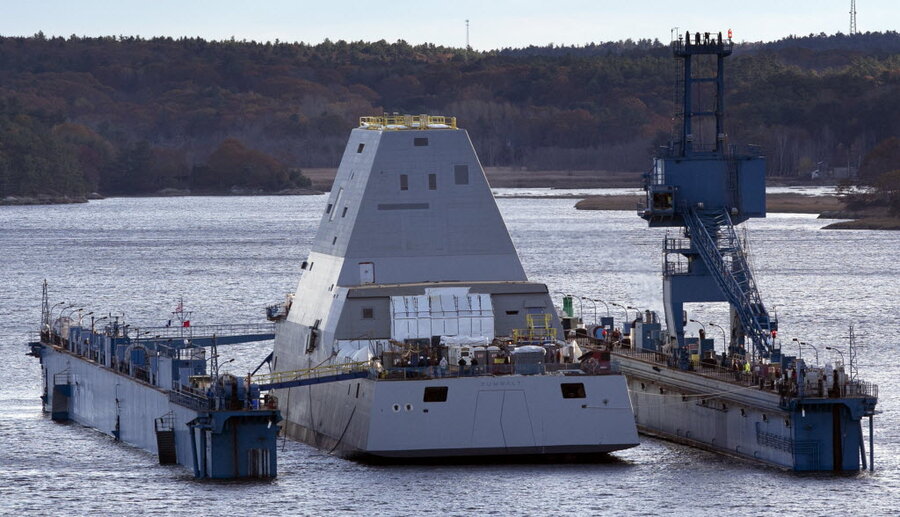Navy new destroyer: USS Zumwalt is bigger, badder than any other destroyer
Loading...
The Navy’s biggest-ever destroyer, the USS Zumwalt, sailed from a Maine port on Monday. The stealth warship is the first of the DDG-1000 class of destroyers, a controversial line of three ships to be deployed to the Pacific during the next three years as sentries to China’s burgeoning naval might.
The USS Zumwalt is big: It is 610 feet long, has an 11,000-square foot flight deck, and displaces 14,564 tons of water. That’s about 100 feet longer than other destroyers, as well a water displacement about 50 percent larger than the next biggest destroyer on the water, the Military Times reported.
Despite its colossal size, Zumwalt is also stealthy, with concealed antennas and an angular frame that makes it much less detectable to radar than are current warships. It also packs a punch. Its “Advanced Gun System” fires warheads at a range of about 63 miles with impeccable precision, three times farther than current destroyers can fire, CNN reported. Its massive electrical capabilities are also expected to support future laser weapons.
But, as precedent suggests with ships of unprecedented size, there’s a problem: Engineers aren’t quite sure if Zumwalt ships are capable of weathering giant waves, according to Defense News. A single sizable swell that hits the ship’s back end might take the ship down, engineers have said. That’s because these ships sport a new, downward-sloping hull that primes the ship to move stealthily, but not necessarily stably; traditional ships have upward-flaring hulls.
The ships are controversial for more than just their Achilles hull: They are expensive – the most expensive Navy ships ever built, to be exact.
Zumwalts began as a dream of the 1990s, imagined as part of the 1991 21st Century Destroyer program, the news website Medium reported. What if a ship could avoid radar detection? What if it could ply the waters unnoticed, a Loch Ness monster of the open seas? What if the US could sport bigger and badder ships than ever before thought possible?
The Department of Defense announced in the 1990s that it would build 32 of the novel class of ships, originally called DD 21 and later DD(X). But the cost of building the ships began to float higher and higher, and, as it did, the Pentagon scaled back the number of behemoth ships it planned to put on the water. In 2003, the Pentagon said it would buy 16 ships. Then, it said seven ships. Then, in 2008, it said three ships.
In 2009, the number of ships was almost reduced to no ships at all, when costs ballooned to over $5 billion per ship, a violation of the Nunn-McCurdy amendment, which says that defense projects whose cost per unit grows more than 15% above what was originally estimated must be tabled. That year, to keep the program going, Department of Defense officials dialed back the cost of the first Zumwalt destroyer to $3.3 billion, with subsequent ships costing about $2.5 billion.
The most recent new destroyer, the US Arleigh Burke class of ships, cost about $1.8 billion each. The Navy is expected to return to building the cheaper class of ships after production wraps up on the three Zumwalts.
All three Zumwalt ships, called Zumwalt, Michael Monsoor, and Lyndon B. Johnson, are due to be based out of San Diego and to be charged with policing the Pacific. Their super structures are constructed at Huntington Ingalls Industries, in Gulfport, Miss., and assembled at Maine's Bath Iron Works, which is part of General Dynamics Marine Systems. The first ship will be delivered to the Navy in 2015, the Washington Times reported.
Zumwalt has hit the water, but it is not quite battle-ready, and Bath Iron Works will keep working on the ship in the water for the next few months. The ship had been due to be christened earlier this month with a bottle of champagne smashed against its hull, but the ceremony was postponed due to the government shutdown. The shipyard expects the champagne slinging to happen sometime in the spring, Fox News reported.
The class of ships is named for Adm. Elmo R. Zumwalt Jr., the chief of naval operations in the early 1970s. He is credited with ordering the Navy to end racial discrimination and allowing women to serve on ships.






